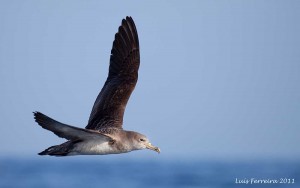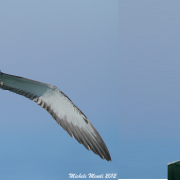Olfactory Navigation
Pelagic seabirds rely on olfactory maps for oceanic navigation
Seabirds can fly for days across featureless oceans to their preferred feeding locations and then fly back to their nests without getting lost. How they do this has long been a mystery. Now through a careful analysis of their flight patterns, researchers have shown that seabirds navigate using an “odour map”. It seems likely that such maps are common place in the animal kingdom having a role in movements like migrations and finding food.
An international team from Italy (ISC-CNR and ISPRA), Portugal (MARE) and UK (Rothamsted Research) has recently published an innovative paper on the Proceedings of the Royal Society B about bird navigation. The term true navigation is frequently used for goal-related orientation towards a given position on earth, usually a home site, towards which no direct sensory contact is available at the current position of an animal. In its strictest sense, the term is only applied if not even familiar landmarks surrounding the goal can be recognized, or are used, which potentially can guide to the goal.
The team has investigated 210 shearwaters from 7 colonies of three different species: Cory’s shearwaters, (Calonectris borealis, North Atlantic Ocean) Scopoli’s shearwaters, C. diomedea Mediterranean Sea, and Cape Verde shearwaters, C. edwardsii, Central Atlantic Ocean) These birds use to nest in rocks usually on small islands and move away hundreds of kilometers in open ocean to hunt on small fishes and other marine organisms and return swiftly at home.
 In scientific literature, the navigational abilities of birds are well demonstrated but we do not know which mechanisms allow birds’ exceptional navigational skills. Here authors provide the first compelling evidence of general olfactory navigation in these birds. It has been hypothesized that this remarkable ability to navigate over vast distances irrespective of wind direction can be attributed to the birds being able to learn an olfactory map or landscape on the basis of wind-borne odours, probably dimethylsulphide, a natural compound naturally occurring over oceans and seas. Using an innovative non-invasive approach, authors provide strong evidence that shearwaters, do indeed, rely on olfactory cues for general oceanic navigation. It is based upon a mathematically rigorous and general description of olfactory-cued navigation in the presence of atmospheric turbulence. Using this theory the research identified the unique hallmark signature of olfactory-cued navigation as being a novel kind of Lévy flight.
In scientific literature, the navigational abilities of birds are well demonstrated but we do not know which mechanisms allow birds’ exceptional navigational skills. Here authors provide the first compelling evidence of general olfactory navigation in these birds. It has been hypothesized that this remarkable ability to navigate over vast distances irrespective of wind direction can be attributed to the birds being able to learn an olfactory map or landscape on the basis of wind-borne odours, probably dimethylsulphide, a natural compound naturally occurring over oceans and seas. Using an innovative non-invasive approach, authors provide strong evidence that shearwaters, do indeed, rely on olfactory cues for general oceanic navigation. It is based upon a mathematically rigorous and general description of olfactory-cued navigation in the presence of atmospheric turbulence. Using this theory the research identified the unique hallmark signature of olfactory-cued navigation as being a novel kind of Lévy flight.
This analysis provides the strongest evidence yet for cognitive odour map navigation in wild birds.
Further information
Authors:
Andrew M. Reynolds, Rothamsted Research, Harpenden, AL5 2JQ, United Kingdom.
Jacopo G. Cecere, ISPRA, 40064 Ozzano dell’Emilia, Italy.
Vitor H. Paiva, Jaime A. Ramos, MARE – Marine and Environmental Sciences Centre, Department of Life Sciences, University of Coimbra, 3004-517 Coimbra, Portugal.
Stefano Focardi, ISC-CNR, 50019 Sesto Fiorentino, Italy.



